“The rise of fractal politics” was first submitted to the Nine Dots Prize in response to the question, “Are digital technologies making politics impossible?” The essay was written as a thought piece prior to the announcement of the 2017 UK General Election.

Fractal Politics
In this essay “the rise of fractal politics” describes the current state of development in advanced capitalist economies. This is a development that has been accelerated by digital technologies while also describing wider ranging changes in contemporary society and politics (Marcuse 2002). Equally, many of these social and political changes have themselves become possible because of digital technologies (Rosa 2013). This is the ever-present reminder that technology is both a product of the society that produces it and a key agent for its change (Laszio 1992).
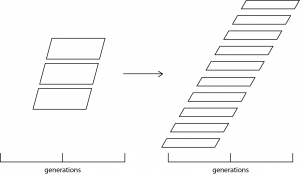
Borrowing some of the terminology of data scientists and the rhetoric of “big data”, the volume, velocity and variety of data (Normandeau 2013) within our everyday lives has now accelerated processes within advanced economies to such an extent that the pace of social change is now clearly evident within the span of a single generation rather than between generations (figure 1) (Rosa 2008). These rapid changes have obscured references to earlier events that provided context, a linking logic or ultimately created collective shared memory. The result is now a continuous sequence of seemingly incoherent, jumbled and momentary current events (figure 2) (Albright 2003).

Event Driven Society
This event driven society is the realisation of the society of the spectacle that was first described by the situationists (Plant 1997) in the 1960s (e.g. DeBord). For the situationists the spectacle generated an endless cycle of events that defined the underlying mechanism of control in contemporary society (DeBord 1994). In the 1960s, and through subsequent decades, the ownership of the means to communicate and disseminate information to a mass audience was the critical control point of society within situationist thinking (Meyrowitz 1987). It was through these authoritative channels that events were propogated and given hegemonic legitimacy.
Fake News
With the popularisation of the use of digital technology this control has now been shifted into the hands of technology companies – who primarily function as advertising companies. Control has become subtler and is now noticeably less mediated. The movement of control away from traditional media and the significant mediating influence that it once provided has resulted in the persistence of political extremes and the loss of any stabilising political hysteresis effect (figure 3). The traditional media’s loss of authority in the face of social media channels has also had the effect of giving equal weight to “alternative facts” (England 2017), “fake news” (Gillin 2017), parody and viral content (Berger and Milkman 2012) as much as journalistically-curated news.
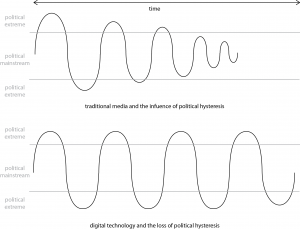
Situationist theory and especially DeBord’s (1994) speculative essay on the “Society of the Spectacle” is the conceptual starting point for fractal politics. However, an ahistorical event-driven society also prompts re-examination of Fukuyama (1992) and Derrida (1994) and their view of societal and political developments within capitalist economies alongside their critics. The arguments clustered around the label of post-politics and including, for example, Beck (1989) and Žižek (1992), also become problematic in, but prognostic of, current circumstances.
The Contemporary Society of the Spectacle
In the original society of the spectacle, individual events supported the recuperation of aberrant or extreme actions back towards the prevailing hegemonic mainstream and its control (Albright 2003; Plant 1997). Resistance and reaction to mainstream control was expressed through the often highly visual act of détournement (Debord and Wolman 1956) – the breaking up of mainstream messages into newly repurposed forms that could represent divergent and critical ideologies. It is a function of mainstream hegemonic control in the society of the spectacle that any extreme views are always recuperated. Even situationist thinking was eventually recuperated into the mainstream through, for example, its inclusion in formal academic curriculum and the popularisation of punk music (Plant 1997).
The society of the spectacle persists and now has additional capabilities brought about through access to digital technology. It is this relationship between digital technology and the society of the spectacle is the focus of discussion for the remainder of this essay.
Resistance and Control
Resistance and control are now both enacted through events of varying scale and scope, ranging from the most personal to the most public all delivered through digital channels. What are described in this essay as strange attractors initiate events for our flickering, largely momentary attention. Our shifting focus from one event to the next is shaped by a desire to seek out self-similarity. In seeking self-similarity we also create our own social media oscillators that overlap and diverge from the social media oscillators of others. These pathways of personal association and resistance navigate a never-ending cycle of events creating ever-more bifurcations of interest and understanding.
…our society is characterized by a cancerous growth of vision, measuring everything by its ability to show or be shown and transmuting communication into a visual journey. It is a sort of epic of the eye and of the impulse to read … Reading (an image or a text), moreover, seems to constitute the maximal development of the passivity assumed to characterize the consumer, who is conceived of as a voyeur in a show-biz society. (de Certeau, 1984, p. xxi)
The argument presented here is that digital technology does not make politics impossible. Instead the claim being made is that technology has irrevocably changed the meaning, experience and processes of politics within advanced capitalist economies. This change is not subjectively “better” or “worse” but rather – and more simply – “different”.
Big Data and Politics
The analogy of fractal politics with the world of mathematics does not extend as far as any form of quantifiable certainty but instead draws inspiration from the derivation of the original term and its association with the concept of fragmentation. In a social sense fragmentation is closely linked to feelings of alienation and the breaking down of stable institutions. In this way, each political action then becomes part of the society of the spectacle in its own right and is experienced as one (more) event among a series of jumbled events.
Advanced economies including the US, the UK, Europe and Australia are all increasingly hallmarked by the fragmentation of previously systematic political and social structures. The most visible evidence of this change is the absence of historicity in the recent outcomes of participatory democracy events where expert predictions based on previous evidence were devalued and inaccurate. The certainty once offered through comparison with historical actions has now been lost amongst the variety, velocity and volume of more recent data that is all simultaneously and immediately accessible. The result is a nearly infinite potential combination of information that can be brought together to service any position in any argument.
Strange Attractors
By the early 20th Century, formal politics was shaped by the certainty of bipartisan party politics in advanced economies where it had become standard. Irrespective of any association with a party, all political activities came to be defined through a binary with alternatives merely representing extremes of two dominant options. Politics and political opinion was contextually – international, national or local – labeled as being left or right. Political parties were either in power, the opposition or irrelevant. Periods of coalition in parliamentary democracies also revealed periods of instability or, at best, nervous stability. Only during periods of extreme political oppression when a single political agenda obtained complete, or near complete, dominance was this political duality fully broken – with disastrous and often genocidal results.
By the second half of the 20th Century, a stream of media events continued to capture the political logic of binary oppositions. Television and radio reported politics as a separate news item discrete from business, entertainment and general items. This separation was a convenience that was crafted to fit broadcast formats. This packaging of politics is seen repeatedly.
Parliamentary elections provide regular popular events that attract commentaries from experts, projections and speculations. The most common public experience of politics was a televised “first to the line” competition that draws heavily on sports commentary. Scandal, the outcomes of poor decisions and questionable ethics were cast in a drama format often distanced from their political implications. However, despite externally changing circumstance and internal policies, political parties became the mechanism for connecting previous events with current events. This connection created reassuring historical continuity.
Disconnected Politics
As we moved into the 21st Century the politics of parliamentary democracies have increasingly become a series of disconnected events. Political activity and thinking is now communicated to online audiences through ‘friends’, ‘friend of friends’ and ‘followers’ with the response to each event now running unmediated through combinations of “public” and “private” channels. Such complexities now mean that the underlying logic for each event will regularly run contrary to expert predictions based on their evaluation of public channels.
Politics – in its many forms – has become increasingly shaped by the events generated around, and by, strange attractors. Strange attractors stand out as beacons that encourage a response in the form of either support or critical response (figure 4). The act of engaging with strange attractors precludes ambivalence. Strange attractors come in the form of people, such as Nigel Farage in the UK and Sarah Palin in the US; events, for example, the movement of refugees across Europe, crises or a referendum; or specific objects including the fetishism for a particular mobile phone brand or game. Strange attractors are primarily accessed through one-way content and two-way communications in traditional and digital media. In some cases it is content that can become its own strange attractor such as the case of a dossier shared through Wikileaks.
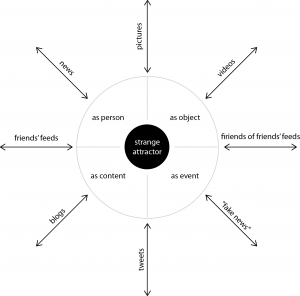
Reality Television and Practice Voting
Strange attractors blur the politics of government and big “P” politics with the politics of entertainment and everyday life in ways that prevent clear distinction. How we vote (both for parliamentary representation and for reality television show winners), the opinions we express both online and face-to-face as well as the actions we take daily all increasingly represent a fractal form of politics.
Many contributory factors have brought us to this current situation including the achievement of universal franchise, ubiquitous access to multiple forms of media, the 24 hour news cycle (Rosenberg and Feldman 2008) and the importance of the attention economy (Beller 2006). The ahistoricism and uncertainty of fractal politics is a result of this narrowly focused, self-centric and rapid movement of attention between strange attractors. As a consequence the opportunity for recuperation to a mainstream position has also become limited.
Fractal politics is enabled through two-way personalised social media, is practiced (in the multiple meanings of the word) through reality television voting as well as online consumer ‘polls’ and encouraged by attention-based consumerism. In this way the consumerism of advanced capitalism has effectively recuperated mainstream politics to becoming just some events among many others.
Self-similarity and the mimetic politics of self
Self-similarity, the underlying principle guiding all fractal mathematics, describes the repetition of a sequence or pattern at all levels of observation. In this branch of mathematics, the goal is to discover these complex patterns. Fractal politics, as an integral aspect of the prevailing social system and in contrast to mathematics, reflects the sociological sensibility that people seek out self-similarity in the form of opinions and worldviews that align with their own identity.
Self-similarity is found at many levels of connection including all forms of (social) media consumption as well as wider combinations of shared and preferred preferences. These are connections that previously would have been mediated through locality, the shared reception of editorial opinion or prior face-to-face associations. Digital, and particularly social media, technologies enable self-similarity to be sought out on a global scale without any prior introductions or context.
The Challenging Echo Chamber
Many commentators refer to an “echo chamber” effect (Jamieson and Cappella 2010) to describe the extreme consequences for this desire for association. The consequence itself is popularly and satirically defined by Godwin’s Law (Godwin 2015), “The longer an online thread of discussion continues the increased likelihood that there will be a reference to Nazis”. These are the extremes left unmediated without political hysteresis.
The need for mimetic association (Taussig 1993) can be regarded as the cause for the current state of political opinion. The variety of opinion that this creates then produces alterity and encourages and even accentuates the politics of difference (Taussig 1993). Seeking self-similarity shapes our personal movement of attention from one strange attractor to another and between the events generate.
The impact of social media oscillators
In 2016 mainstream media expressed almost continuous surprise as participatory democracy ran contrary to the predictions of experts. The referenda in the UK and Italy and the US and Australian elections are all examples of events that generated surprise. Social media oscillators coalesced around the debates that lead to the main event and significantly determined the outcomes of these events.
Social media oscillators are personal but overlap heavily with the oscillators of those who share self-similarity (figure 5). A social media oscillator charts the movement of attention between strange attractors. Social media oscillators move between those strange attractors that we identify with and those that we react against.
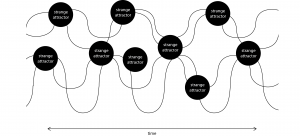
No Filters
Social media oscillators replace political hysteresis in fractal politics creating new political dynamics. Recuperation to a mainstream political orthodoxy, control by mediating dominant media channels and structured political binarism all become problematic with social media oscillators. In physical systems, hysteresis dampens out extremes and creates an environment of certainty and regularity.
Most importantly, hysteresis in physical systems prevents damage and breakage in the system by not responding to each small action with a similarly small counter reaction. Instead, hysteresis is a single corrective response to a series of smaller actions. A single reaction to multiple actions ensures longer-term stability and systemic efficiency.
Without the certainty of future corrective actions provided by political hysteresis, the logic of social media oscillators are found at a smaller, more personal, scale. This change to the political landscape does not preclude eventual identification of this underlying logic. However, current political analysis techniques are still founded on assumptions from an earlier “easier” political environment. Recognition of the increased velocity, volume and variety of data that hallmarks the new political environment also provides the basis for the solution that will predict and reveal its new underlying logic.
Ever more smaller bifurcations
With social media oscillators moving between strange attractors rapidly and without an immediately discernible logic each event becomes fractal. Coherence can only be found at the smallest units of examination leaving the overall result of an event appearing chaotic and unordered (figure 6). Meaning is generated through the influences of all forms of media as well as within personal spheres of interest and influence. The logic for each event is then found at the current endpoint of ever-smaller bifurcations of different social media oscillators.
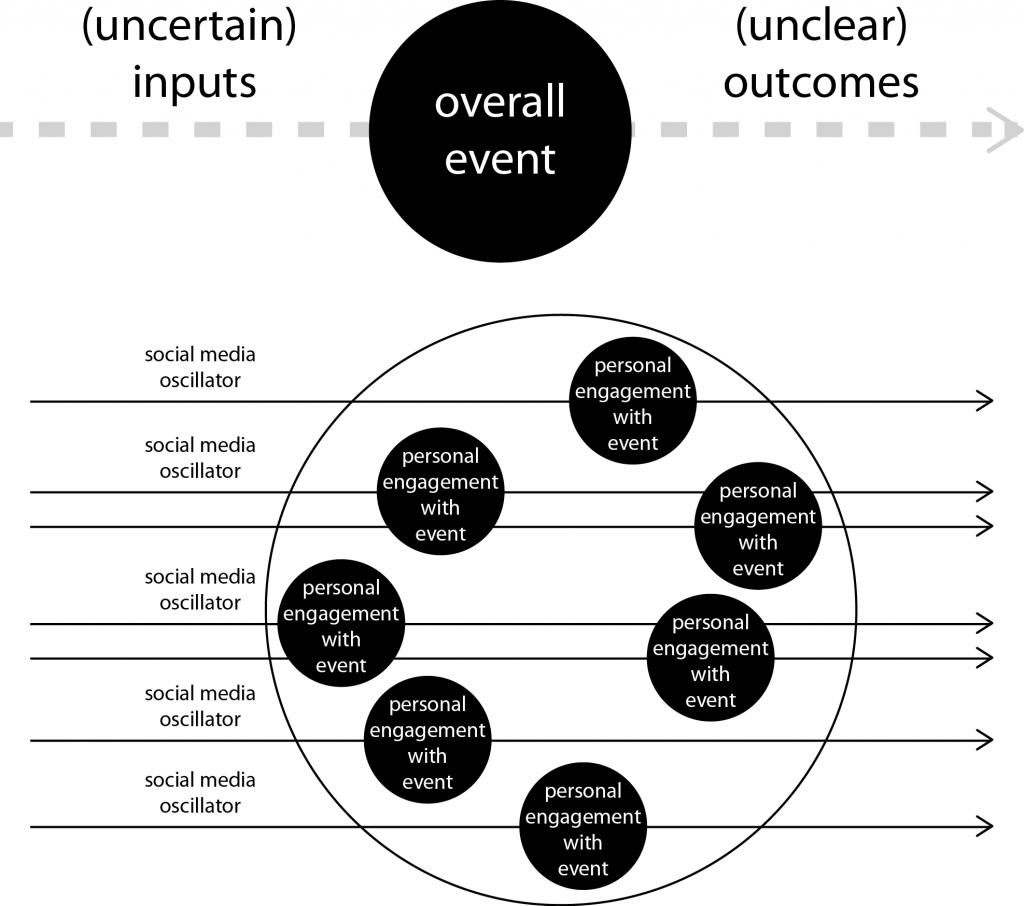
Consolidation – the rejoining of bifurcated social media oscillators – happens temporarily around strange attractors. It is difficult for politicians and political parties to now consolidate public opinion (and recuperate extremes) as social media provides no distinction between the strange attractors of big “P” politics and the strange attractors of reality television voting, parody, “fake news” or events that are confined solely to a group of friends (and friends of friends).
The significance of events
Where the influence of political events may have previously been given more significant weighting within traditional mediated news reporting, social media presents each events with equal weight within a continuous stream of activity. The significance of each event is not determined by the emphasis placed upon it by commentators or traditional media but in its position within a social media oscillator and the particular bifurcation by which it has been reached. An individual may claim that they are not “into” politics but should be seen as a response to their understanding of traditional politics. The same individual’s social media oscillations and bifurcations as they choose their engagement with individual events is an act of the politics now facilitated by digital technology.
What is politics?
Digital technology has enabled a new form of politics that appears as being largely personal and a reaction to the “made for media” party politics of the 20th Century. The changes are simultaneously significant – in the lost of the power of traditional broadcast media – and marginal – while the agendas of traditional political parties still dominant parliamentary politics and debate. The key difference in this new form of politics is the flattening out of the received importance of one event over another. A parliamentary election is now only as significant as the vote for a reality television final winner or the birth of a friend’s child. Each event occupies space on a social media timeline before disappearing off the screen to be substituted by the next event.
Political association has always been based on notions of self-similarity and mimesis. What has changed is the much finer degree of granularity that is possible with digital technology. The Labor party in the UK may traditional represent the “working people” but the much smaller Facebook group for ex-employees of BHS is significantly more meaningful to its members and shares equal importance in their digital news stream. In fact, the concerns over “non-Labor” supporters joining the UK Labor party during its leadership contest in 2016 was further evidence that the meaning of association and membership has become a noticeably more fluid concept in the era of fractal politics.
Politics for the Powerful
The new politics brought by digital technology does not necessarily represent the realisation of “people power” or participatory democracy. The manipulation of the event and its use to reflect power back towards the powerful is well understood. It is a tactic still deployed by the powerful including political parties and large companies. What is still underestimated is the equality of the social media stream and the bifurcations of personal social media oscillations that it produces.
This sense (and possibly illusion) of choice may never be precisely knowable but neither is it completely random or impenetrable. The volume, velocity and variety of data that digital technology creates will be where insight is found. Data-driven politics through its closest examination will reveal the patterns and the logic that will explain (at least) the results of the biggest formal and public political events. Politics is possible with digital technology but we are yet to fully completely understand how it now functions in a data-driven, information-rich world.
References
Albright, D. (2003) ” Tales of the city: applying Situationist social practice to the analysis of the urban drama”, Criticism, Winter.
Beck, Ulrich (1992) Risk Society: Towards a New Modernity. London: Sage
Beller, J. (2006) The cinematic mode of production : attention economy and the society of the spectacle. Dartmouth College Press, Hanover.
Berger, J. and Milkman, K. (2012) “What makes online content viral?”, Journal of Marketing Research, 49(2), pp.192-205.
Debord, G. [1967](1994) Society of the Spectacle, New York: Zone Books.
Debord, G., & Wolman, G. (1956) “A user’s guide to détournement”. Les Lèvres Nues, No. 8, May, www.bopsecrets.org/SI/detourn.htm
De Certeau, M. (1984) The practice of everyday life, Berkeley: University of California Press.
Derrida, J. (1994) Spectres of Marx: State of the Debt, the Work of Mourning and the New International. Routledge: London.
England, C. (2017) “George Orwell’s 1984 sells out on Amazon as Trump adviser Kellyanne Conway refers to ‘alternative facts’”, The Independent, 27th January, www.independent.co.uk/arts-entertainment/books/news/george-orwell-1984-alternative-facts-donald-trump-adviser-kellyanne-conway-amazon-sellout-bestseller-a7548666.html
Fukuyama, F. (1992) The End of History and the Last Man. Free Press: New York.
Gillin, J. (2017) “Fact-checking fake news reveals how hard it is to kill pervasive ‘nasty weed’ online”, Pundifact, 27th January, www.politifact.com/punditfact/article/2017/jan/27/fact-checking-fake-news-reveals-how-hard-it-kill-p/
Godwin, M. (2015) “Sure, call Trump a Nazi. Just make sure you know what you’re talking about.”, Washington Post, 14th Dec, www.washingtonpost.com/posteverything/wp/2015/12/14/sure-call-trump-a-nazi-just-make-sure-you-know-what-youre-talking-about
Jamieson, K. and Cappella J. (2010) Echo Chamber: Rush Limbaugh and the Conservative Media Establishment, Oxford University Press: Oxford.
Laszio, E. (1992) “Information technology and social change: An evolutionary systems analysis”, Systems Research and Behaviourial Science, 37(4), October, pp.237-49.
Marcuse, H. (2002) One-Dimensional Man, Routledge Classics: Abingdon.
Meyrowitz, J. (1987) No Sense of Place: the impact of electronic on social behavior, Oxford University Press: Oxford.
Normandeau, K. (2013) “Beyond Volume, Variety and Velocity is the Issue of Big Data Veracity”, 12th Sept, insidebigdata.com/2013/09/12/beyond-volume-variety-velocity-issue-big-data-veracity/
Plant, S. (1997) The most radical gesture: The Situationist International in a postmodern age. Routledge, London.
Rosa, H. (2008) “The Universal underneath the multiple, Social acceleration as a means to understanding modernity”, in V. Schmidt (ed.) Modernity at the beginning of the 21st Century, Cambridge Scholars Press: Newcastle.
Rosa, H. (2013) Social Acceleration: A new theory of modernity, New York: Columbia University Press.
Rosenberg, H. and Feldman, C. (2008) No time to think: the menace of media speed and the 24 hour news cycle. Continuum: New York.
Taussig, M. (1993) Mimesis and Alterity: A particular history of the senses. Routledge: New York.
Žižek, S. (1989) The Sublime Object of Ideology. New York: Verso.